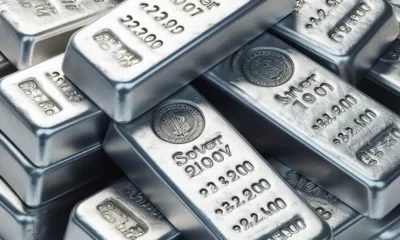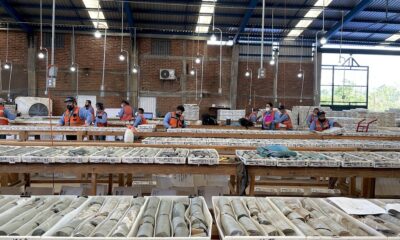Analys
Silver outlook to Q4 2021: A year for the hybrid metal

Nitesh Shah, Director, Research, WisdomTree, provides his 2021 outlook for silver, including the potential drivers of performance and the continued recovery of industrial demand.

“After a slow start, silver outpaced gold and most industrial metals in 2020. Initially riding gold’s defensive coattails and then getting a tailwind from its industrial traits, silver was an outperformer, gaining 47% in 2020. That compares to gold (24%), copper (27%) and nickel (21%). Silver’s hybrid status served it well in 2020 and we expect more of the same in 2021. As we articulated in Gold outlook to Q4 2021: at the crossroads of hope and fear, we start 2021 with the hope that COVID-19 vaccines will offer a route out of the malaise that the pandemic has wreaked on the health of the human population and the economies that we operate in. However, as has been abundantly clear in December 2020, the path to the recovery is likely to have many bumps along the road. Silver, playing both a defensive and cyclical role could do very well this year.
“Silver’s hybrid status has not gone unnoticed by investors. Silver held in exchange traded products (ETPs) rose to an all-time high in 2020 (Figure 1), and more remarkably at a pace never seen before. With 275mn ounces of silver added to silver exchange traded commodities in 2020, the year marks more than double the next highest year of silver ETP gains (2009 with 137mn ounces added). There was strong buying when silver was under-priced relative to gold in the first half of 2020. However, that buying slowed in the second half of the year as silver prices caught up with gold.
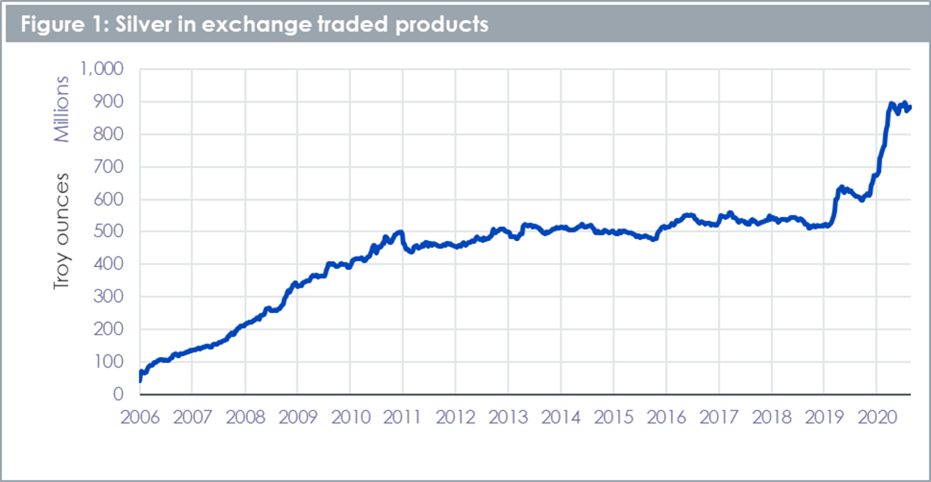
Framework
In “Gold and silver: similar, but different”, we argued that silver’s price performance is 80% correlated with gold. In our modelling framework, gold price is therefore the main driver of silver price. However, we also find the following variables as important drivers of silver price:
- Growth in manufacturing activity – more than 50% of silver’s use is in industrial applications (in contrast to gold where less than 10% comes from that sector). We use global manufacturing Purchasing Managers Index (PMI) as a proxy for industrial demand
- Growth in silver inventory – rising inventories signal greater availability of the metal and hence is price negative. We use futures market exchange inventory as a proxy
- Growth in mining capital investment (capex) – the more mines invest, the more potential supply we will see in the future. Thus, we take an 18-month lag on this variable. Given that most silver comes as a by-product of mining for other metals, we look at mining capex across the top 100 miners (not just monoline silver miners).
Gold outlook Q4 2021: at the crossroads of hope and fear
In Gold outlook to Q4 2021: at the crossroads of hope and fear we laid out our forecasts under three scenarios.
- Consensus – based on consensus forecasts for all the macroeconomic inputs and an assumption that investor sentiment towards gold remains flat at where it is today.
- Continued economic uncertainty – further monetary intervention, possibly through yield curve control – limits Treasury yields and the US dollar continues to weaken, while investor sentiment towards gold strengthens.
- Hawkish Fed – despite having adjusted its inflation target, the Federal Reserve (Fed) behaves hawkish and Treasury yields rise substantially, the US dollar appreciates back to where it was in June 2020 and inflation remains way below target. As US dollar debasement fears recede, positioning in gold futures declines.
In our silver forecast, we focus on the ‘Continued economic uncertainty scenario’ where the gold price reaches US$2130/oz at the end of the forecast horizon.
Silver forecasts
“We believe in growth terms, silver could outpace gold, reaching US$34/oz in Q4 2021 (33.6% from today’s levels, versus 13.3% for gold. We explain the other drivers to this forecast below.
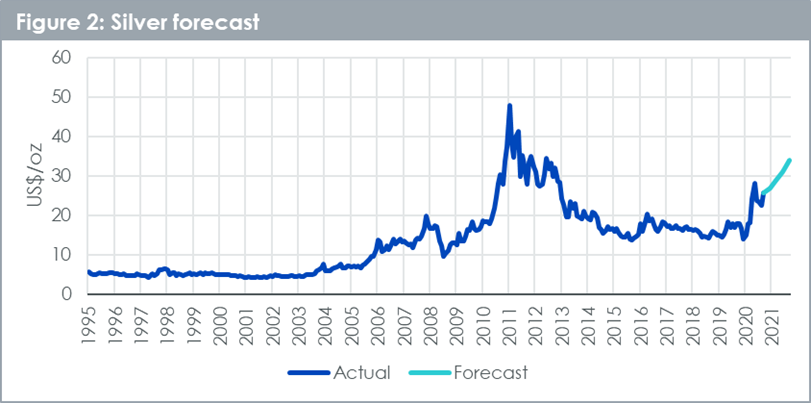
Industrial demand to continue to recover
“Manufacturing Purchasing Managers Indices (PMIs) have risen strongly in the past few months and are now in the expansionary post-50 region (Figure 3). Coming from a period of tight lockdowns, it’s unsurprising that the relative recovery from spring 2020 levels for the PMIs was strong as lockdown conditions eased. Renewed lockdowns could temporarily halt the improvement, but in general many businesses – with the support of a monetary and fiscal stimulus – will continue to see improvement. As with most historic recoveries, the pace of rebound is likely to slow in in the second half of the year. However, peaking at over 55, the PMIs indicate plenty of industrial demand for silver to be expected.
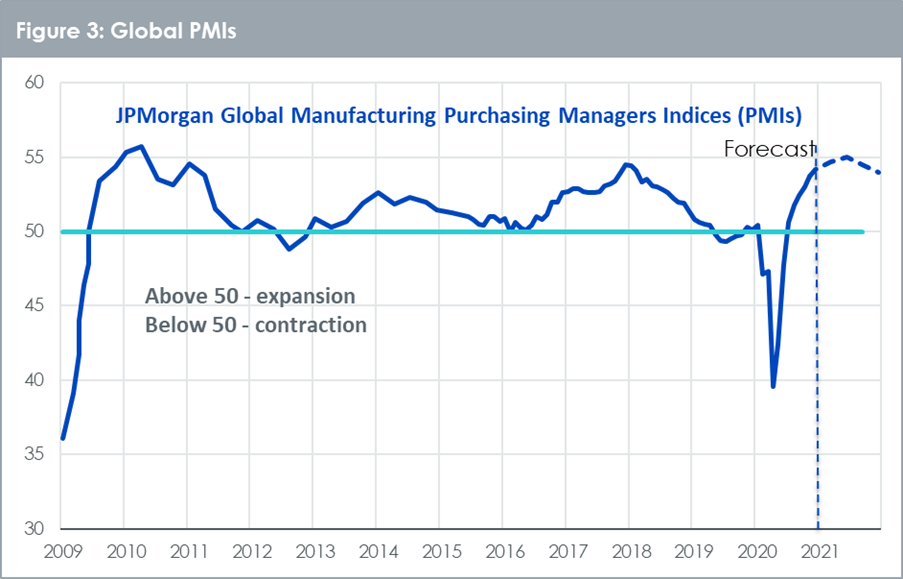
Mining supply could expand in 2021
“Our model approach uses the capital expenditure in mines as a proxy for future silver supply. While capital expenditure has declined in the past quarter (Figure 4), given the lag that we apply to this input, the rising capital expenditure we saw before that acts as a headwind for silver prices in our model approach.
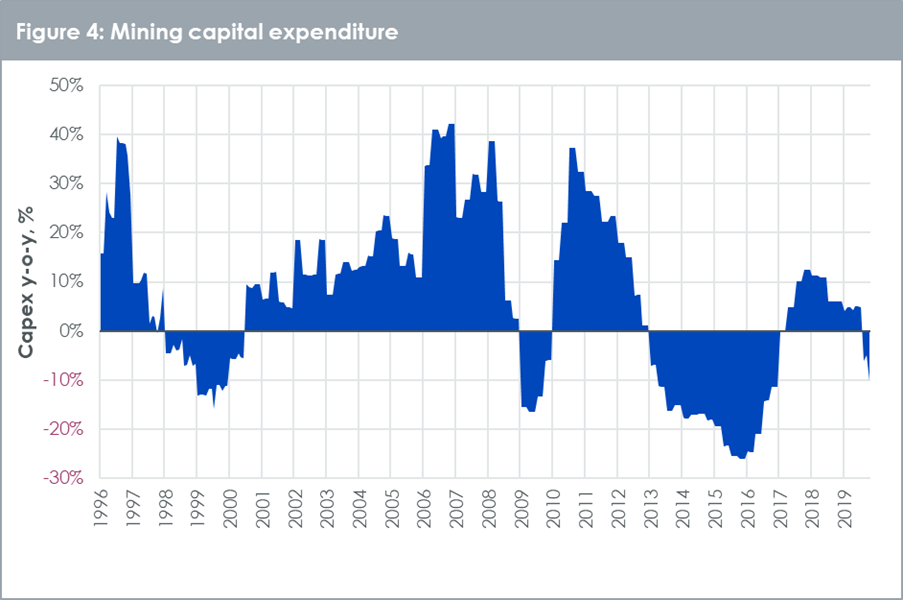
“We know that earlier in 2020 many mines were unable to operate at full capacity due to social distancing and therefore silver mine production has been lower than it would have otherwise been. Figure 5 shows how much these COVID-19 related losses were estimated to be by Metals Focus. Assuming we don’t see lockdowns reintroduced in 2021, we are very likely to see mine production of silver rebound.
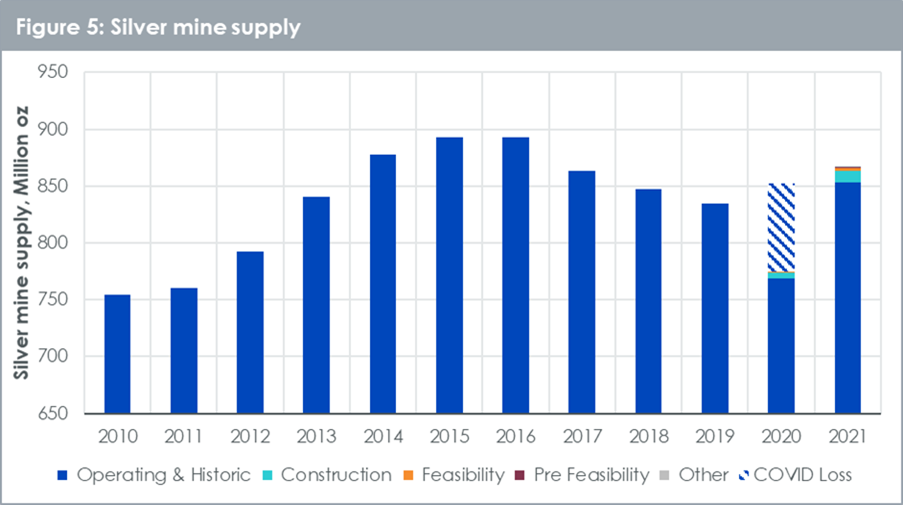
Silver exchange inventory rising again
“Silver inventory in Comex warehouses took a dip earlier in 2020 as sourcing metal became difficult under COVID-19 related operational hurdles (including flying metal from refiners in Europe, which became very difficult during lockdown). However, the supply of silver at the futures exchange was always plentiful and did not experience as sharp a dislocation from the over-the-counter spot bullion market as gold did. In recent months silver inventory on exchange has resumed its upward trajectory (Figure 6). We expect this trend to continue, adding some headwinds to silver price.
“We should note that there is a distinction between registered and eligible inventory. Eligible means the metal meets exchange’s requirements but has not been pledged as collateral against a futures market transaction. Registered means the metal meets requirements and has been pledged as collateral for futures market transactions. Eligible can easily be converted into registered, and that is why we look at the aggregate. However, most of the gains in recent years have come in the form of eligible rather than registered. That could simply be the choice of warehousing more in Comex warehouses rather than other warehouses. Nevertheless, the greater source of visible inventory has had a price dampening impact on silver. We expect rising inventory to continue to have this effect in the future.
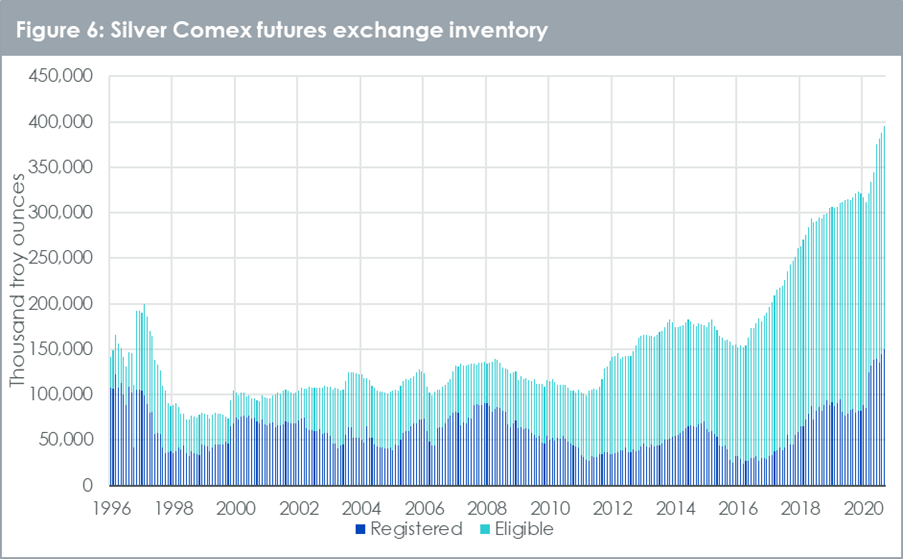
Silver is not as cheap as it was in 2020
“After spiking to a modern-era high in Q1 2020, the gold-to-silver ratio is now sitting only slightly above its historic average since 1990 (Figure 7). In this regard silver is not as ‘cheap’ as it was in Q1 2020. We still expect silver outperformance over gold this year however, and our current forecasts (under the ‘continued economic uncertainty’ scenario) would put the gold-to-silver ratio at 63 at the end of 2021, just below the historic average of 68.
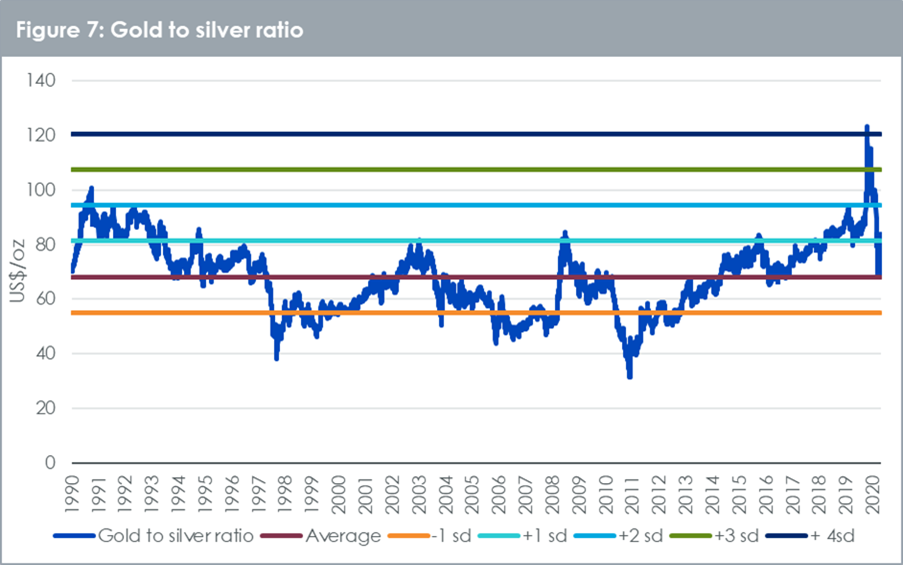
Conclusion
“Although silver faces some headwinds from potential supply increases, its correlation to gold should act as strong tailwind. Moreover, its hybrid status will allow it to benefit from a cyclical upswing, as we pass the ‘bumps in the road’ in combating the COVID-19 pandemic. Silver has outperformed gold in 2020 and its historic high gold-beta may continue to see it outperform gold when gold is rising.”
Nitesh Shah, Director, Research, WisdomTree
Analys
Brent crude ticks higher on tension, but market structure stays soft

Brent crude has climbed roughly USD 1.5-2 per barrel since Friday, yet falling USD 0.3 per barrel this mornig and currently trading near USD 67.25/bbl after yesterday’s climb. While the rally reflects short-term geopolitical tension, price action has been choppy, and crude remains locked in a broader range – caught between supply-side pressure and spot resilience.

Prices have been supported by renewed Ukrainian drone strikes targeting Russian infrastructure. Over the weekend, falling debris triggered a fire at the 20mtpa Kirishi refinery, following last week’s attack on the key Primorsk terminal.
Argus estimates that these attacks have halted ish 300 kbl/d of Russian refining capacity in August and September. While the market impact is limited for now, the action signals Kyiv’s growing willingness to disrupt oil flows – supporting a soft geopolitical floor under prices.
The political environment is shifting: the EU is reportedly considering sanctions on Indian and Chinese firms facilitating Russian crude flows, while the U.S. has so far held back – despite Bessent warning that any action from Washington depends on broader European participation. Senator Graham has also publicly criticized NATO members like Slovakia and Hungary for continuing Russian oil imports.
It’s worth noting that China and India remain the two largest buyers of Russian barrels since the invasion of Ukraine. While New Delhi has been hit with 50% secondary tariffs, Beijing has been spared so far.
Still, the broader supply/demand balance leans bearish. Futures markets reflect this: Brent’s prompt spread (gauge of near-term tightness) has narrowed to the current USD 0.42/bl, down from USD 0.96/bl two months ago, pointing to weakening backwardation.
This aligns with expectations for a record surplus in 2026, largely driven by the faster-than-anticipated return of OPEC+ barrels to market. OPEC+ is gathering in Vienna this week to begin revising member production capacity estimates – setting the stage for new output baselines from 2027. The group aims to agree on how to define “maximum sustainable capacity,” with a proposal expected by year-end.
While the IEA pegs OPEC+ capacity at 47.9 million barrels per day, actual output in August was only 42.4 million barrels per day. Disagreements over data and quota fairness (especially from Iraq and Nigeria) have already delayed this process. Angola even quit the group last year after being assigned a lower target than expected. It also remains unclear whether Russia and Iraq can regain earlier output levels due to infrastructure constraints.
Also, macro remains another key driver this week. A 25bp Fed rate cut is widely expected tomorrow (Wednesday), and commodities in general could benefit a potential cut.
Summing up: Brent crude continues to drift sideways, finding near-term support from geopolitics and refining strength. But with surplus building and market structure softening, the upside may remain capped.
Analys
Volatile but going nowhere. Brent crude circles USD 66 as market weighs surplus vs risk

Brent crude is essentially flat on the week, but after a volatile ride. Prices started Monday near USD 65.5/bl, climbed steadily to a mid-week high of USD 67.8/bl on Wednesday evening, before falling sharply – losing about USD 2/bl during Thursday’s session.

Brent is currently trading around USD 65.8/bl, right back where it began. The volatility reflects the market’s ongoing struggle to balance growing surplus risks against persistent geopolitical uncertainty and resilient refined product margins. Thursday’s slide snapped a three-day rally and came largely in response to a string of bearish signals, most notably from the IEA’s updated short-term outlook.
The IEA now projects record global oversupply in 2026, reinforcing concerns flagged earlier by the U.S. EIA, which already sees inventories building this quarter. The forecast comes just days after OPEC+ confirmed it will continue returning idle barrels to the market in October – albeit at a slower pace of +137,000 bl/d. While modest, the move underscores a steady push to reclaim market share and adds to supply-side pressure into year-end.
Thursday’s price drop also followed geopolitical incidences: Israeli airstrikes reportedly targeted Hamas leadership in Doha, while Russian drones crossed into Polish airspace – events that initially sent crude higher as traders covered short positions.
Yet, sentiment remains broadly cautious. Strong refining margins and low inventories at key pricing hubs like Europe continue to support the downside. Chinese stockpiling of discounted Russian barrels and tightness in refined product markets – especially diesel – are also lending support.
On the demand side, the IEA revised up its 2025 global demand growth forecast by 60,000 bl/d to 740,000 bl/d YoY, while leaving 2026 unchanged at 698,000 bl/d. Interestingly, the agency also signaled that its next long-term report could show global oil demand rising through 2050.
Meanwhile, OPEC offered a contrasting view in its latest Monthly Oil Market Report, maintaining expectations for a supply deficit both this year and next, even as its members raise output. The group kept its demand growth estimates for 2025 and 2026 unchanged at 1.29 million bl/d and 1.38 million bl/d, respectively.
We continue to watch whether the bearish supply outlook will outweigh geopolitical risk, and if Brent can continue to find support above USD 65/bl – a level increasingly seen as a soft floor for OPEC+ policy.
Analys
Waiting for the surplus while we worry about Israel and Qatar

Brent crude makes some gains as Israel’s attack on Hamas in Qatar rattles markets. Brent crude spiked to a high of USD 67.38/b yesterday as Israel made a strike on Hamas in Qatar. But it wasn’t able to hold on to that level and only closed up 0.6% in the end at USD 66.39/b. This morning it is starting on the up with a gain of 0.9% at USD 67/b. Still rattled by Israel’s attack on Hamas in Qatar yesterday. Brent is getting some help on the margin this morning with Asian equities higher and copper gaining half a percent. But the dark cloud of surplus ahead is nonetheless hanging over the market with Brent trading two dollar lower than last Tuesday.

Geopolitical risk premiums in oil rarely lasts long unless actual supply disruption kicks in. While Israel’s attack on Hamas in Qatar is shocking, the geopolitical risk lifting crude oil yesterday and this morning is unlikely to last very long as such geopolitical risk premiums usually do not last long unless real disruption kicks in.
US API data yesterday indicated a US crude and product stock build last week of 3.1 mb. The US API last evening released partial US oil inventory data indicating that US crude stocks rose 1.3 mb and middle distillates rose 1.5 mb while gasoline rose 0.3 mb. In total a bit more than 3 mb increase. US crude and product stocks usually rise around 1 mb per week this time of year. So US commercial crude and product stock rose 2 mb over the past week adjusted for the seasonal norm. Official and complete data are due today at 16:30.
A 2 mb/week seasonally adj. US stock build implies a 1 – 1.4 mb/d global surplus if it is persistent. Assume that if the global oil market is running a surplus then some 20% to 30% of that surplus ends up in US commercial inventories. A 2 mb seasonally adjusted inventory build equals 286 kb/d. Divide by 0.2 to 0.3 and we get an implied global surplus of 950 kb/d to 1430 kb/d. A 2 mb/week seasonally adjusted build in US oil inventories is close to noise unless it is a persistent pattern every week.
US IEA STEO oil report: Robust surplus ahead and Brent averaging USD 51/b in 2026. The US EIA yesterday released its monthly STEO oil report. It projected a large and persistent surplus ahead. It estimates a global surplus of 2.2 m/d from September to December this year. A 2.4 mb/d surplus in Q1-26 and an average surplus for 2026 of 1.6 mb/d resulting in an average Brent crude oil price of USD 51/b next year. And that includes an assumption where OPEC crude oil production only averages 27.8 mb/d in 2026 versus 27.0 mb/d in 2024 and 28.6 mb/d in August.
Brent will feel the bear-pressure once US/OECD stocks starts visible build. In the meanwhile the oil market sits waiting for this projected surplus to materialize in US and OECD inventories. Once they visibly starts to build on a consistent basis, then Brent crude will likely quickly lose altitude. And unless some unforeseen supply disruption kicks in, it is bound to happen.
US IEA STEO September report. In total not much different than it was in January

US IEA STEO September report. US crude oil production contracting in 2026, but NGLs still growing. Close to zero net liquids growth in total.

-

 Nyheter4 veckor sedan
Nyheter4 veckor sedanMeta bygger ett AI-datacenter på 5 GW och 2,25 GW gaskraftverk
-

 Nyheter4 veckor sedan
Nyheter4 veckor sedanAker BP gör ett av Norges största oljefynd på ett decennium, stärker resurserna i Yggdrasilområdet
-

 Nyheter4 veckor sedan
Nyheter4 veckor sedanSommarens torka kan ge högre elpriser i höst
-

 Analys4 veckor sedan
Analys4 veckor sedanBrent edges higher as India–Russia oil trade draws U.S. ire and Powell takes the stage at Jackson Hole
-

 Nyheter3 veckor sedan
Nyheter3 veckor sedanMahvie Minerals är verksamt i guldrikt område i Finland
-

 Analys3 veckor sedan
Analys3 veckor sedanIncreasing risk that OPEC+ will unwind the last 1.65 mb/d of cuts when they meet on 7 September
-

 Nyheter3 veckor sedan
Nyheter3 veckor sedanNeil Atkinson spår att priset på olja kommer att stiga till 70 USD
-

 Analys2 veckor sedan
Analys2 veckor sedanOPEC+ in a process of retaking market share







